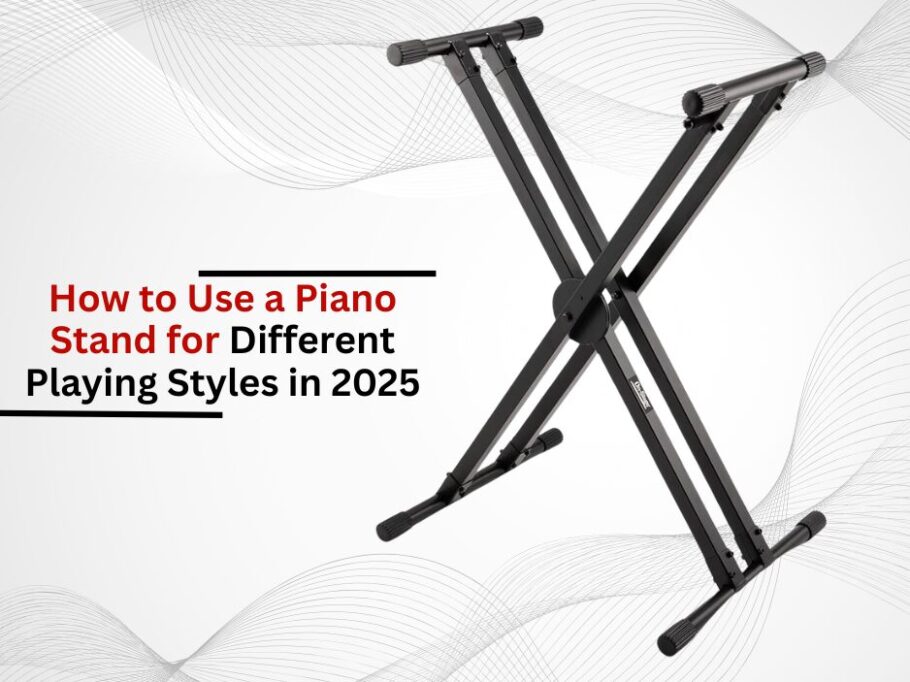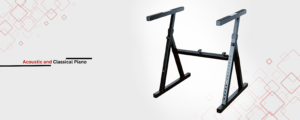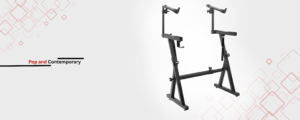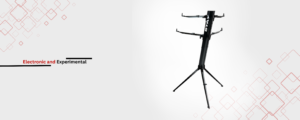In 2025, a piano stand is no longer a simple accessory; it has become an intricate tool for enhancing performance across various instruments. Advances in materials and technology have changed the way every musician, whether classical or modern, interacts with their devices. Knowing how to properly use a stand’s features to ensure both comfort and looseness enables one to enjoy every playing style without the limitations of genre.
To know more, read: The Evolution of Keyboard Stands: From 1980s X-Frames to 2025 Smart Stands
Acoustic and Classical Piano: Posture Correction
Adjust Posture and Height:
The listed height of the keyboard should be at elbow level while seated to the player’s (28-30 inches). For grand pianos, fixed hardwood stands with non-slip padding are preferred as they reduce vibration to aid in clear and crisp tone reproduction.
Backrest Emulation:
Ensuring tilt and angle customization is important; the slight backward tilt of the stand (emulating 5-10 degrees) enhances proper wrist posture for assisting in complicated passages on traditional acoustic pianos.
Improvisation & Jazz: Active Flow of Movements
Energetic and dynamic movement changes to standing or sitting positions require a flexible design that jazz pianists use. To configure the piano to jazz standards.
Adjustable Width and Portability:
Like Z-style stands, quick band-aid-enabled stands allow free movement for the energetic piano players. Being able to effortlessly pull and push blocks within the stand grants mid-performance height enablement quickly, facilitating the needs of piano players on the go.
Peripheral Gear Space:
Also, stands with modular tiers provide space for a secondary MIDI controller or tablets used for storing chord charts, aiding in layered improvisational playing.
Need this in bulk? You can get this from wholesale – keyboard stand
If you need this at the best prices, you might check out this new platform – keyboard stand
Pop and Contemporary: Technology Integration
The modern pop configuration typically includes a digital piano with associated production equipment, which requires integration of technology.
Multi-tier stands:
Synthesizers, drum machines, and even laptops can fit into two or three tiers. Stability under shared weight is maintained with reinforced crossbars.
Cable Management Systems:
Professional USB hubs, charging pads, and cable channels reduce mess and streamline active studio or live performance.
Electronic and Experimental: Modular Customization
Experimental artists require adaptable stands to manipulate sounds through unorthodox techniques.
Modular Attachments:
Pedals, microphone mounts and other add-ons could be easily snapped or magnetically attached to the stand to be used as a clip-on modular framework. Set angles of tilt to support hands-on sampling or prepared piano techniques.
Vibration Dampening:
Padding designed to mitigate resonance keeps the piano isolated from vibrations, which ensures sound purity during amplified performances.
Portable and Gig Setups: Compact and Portable Durability
Musicians on the go look for collapsible yet robust stands.
Foldable Designs:
A standard weight of under 10 lbs becomes ultra-lightweight. Legs fold and easily fit into portable carry cases, which are ideal for multi-venue tours or busking.
Quick Release Mechanisms:
Performance focus remains uninterrupted by device assembly and disassembly seamlessly taking place without tools in the response to timed set-window mission shifts.
Future Trends in Stand Design for Piano (2025)
Future innovations are prone to modifying the functionality and playing methods that an individual can perform on the stand
Smart Materials:
The self-leveling alloys alongside the memory foam padding adjust directly to the pianist’s position, thus reducing the time set for preparation.
AI-Driven Ergonomics:
Stands embedded with sensors that monitor posture give real-time feedback through connected applications and notify users of any potential strain.
Sustainable Builds:
The bamboo and the recycled composites are leading in eco-friendly designs for sustainable constructions because they are reusable and strong.
Conclusion
The year 2025 envisions piano stands as active participants in the expressional dynamics of music, seamlessly shifting to align with genres as diverse as the performers themselves. Brands such as 5 Core, Roland, K&M, and On Stage continue to lead this change, providing classical, jazz, pop, and experimental solutions. At this juncture, brands focus on the integration of technology and modularity. The future of piano stands is still uncertain. Unpredictable advancements in AI, eco-friendliness, or materials science could change the scope of performance setups.






